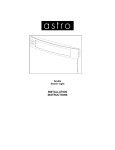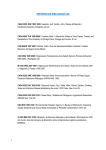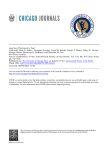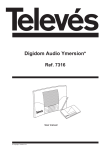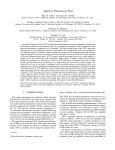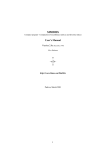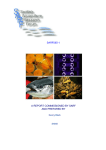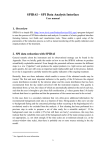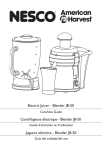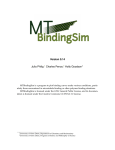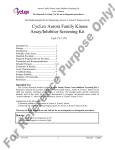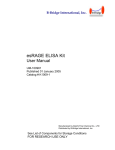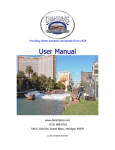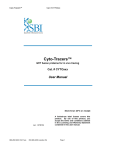Download PDF
Transcript
Algacleaner Ultrasonic equipment to relieve algal blooms from ponds, irrigation reservoirs, and lakes without chemical products. www.spel.com.au Applications IRRIGATION RESERVOIRS The Technology It is now possible to prevent the bloom of algae in your pond, irrigation reservoir, lake, fountain, cooling towers, etc, without the need for chemical products. SPEL ultrasonic equipment will ensure the bloom is eliminated in the most sustainable method possible. It is easy to install. All you need to do is float the device in the water and connect it to a power source or solar panel. ponds Advantages •Ecological •Non-toxic • Causes no harm to humans, animals and plants • Environmental — no need for chemical products • No need for maintenance • Easy to install • 24/7 service • Low power consumption lakes swimming pools 2 Operating principles The ultrasonic transmitter produces a high-frequency mechanical vibration in the water, which reverberates throughout the pond at great distances due to the capacity of water to transmit sound vibration. Ultrasonic signals are emitted in pulse waves of variable shape and duration at frequencies ranging from 20kHz to 60kHz. The algae cannot tolerate this vibration. It prevents them from reproducing and destroys them. Other organisms including bacteria are also broken down, resulting in clearer and higher-quality water. Superior animals such as fish, reptiles, amphibians and birds are not affected. Quite the opposite – the absence of chemical products means the wildlife leads to healthier existence and gains up to 20% in weight. Prevention of cellular growth by means of ultrasonic pulsation The growth of algae, fungi, protozoa and other eukaryotic, aquatic microorganisms is basically a result of cellular reproduction. This process, known as mitosis, enables the cells to equally distribute their genetic material (DNA) among the two daughter cells. This event can be observed under a microscope and consists of a dark thick string-shaped material resembling wool (chromosomes, the carriers of the DNA) which settles in the centre of the cell and then splits and moves to opposite sides. The cell membrane then constricts and separates the mother cell into two daughter cells. This process, whereby the chromosomes separate and move to opposite sides of the cell is called anaphase, and is mediated by fibres know as microtubules which assemble from the sides to the centre of the chromosomes. When all the chromosomes are attached to the microtubules, the signal is given to proceed to the state of anaphase where the chromosomes are dragged to the sides by these fibres. Any disturbance whatsoever will destabilize the microtubule chain, the cellular cycle and prevent the cells from multiplying. This is how the ultrasonic pulses disrupt the polymerisation of the microtubules, thereby stemming cellular growth. Installation and operating capacity The operating capacity of the SPEL Algacleaner depends on the semi-circular surface area swept by the acoustic signal emitted by the equipment. The surface area is comprised of an angle of around 168° and a range radius that depends on the geographic region displayed in the map below, with an estimated average range of 100 metres. The equipment should be installed with the aim of covering the greatest surface area possible. In the event of doubt with regard to irregular geometry or such, we advise you to contact SPEL. A special accessory is provided for anchoring the equipment. Algae can evolve as a result of the intensity of solar radiation, the number of hours of sunlight, the nutrients contained in the water used to fill the pond, the nutrients brought by the wind and the animals and birds that frequent the same and also if the sides of the pond are made of plastic or earth and contain plants. In certain cases it may be advisable to use both an ultrasonic and a conventional system, albeit on a lesser scale than usual. Map of range The SPEL Algacleaner is the most powerful equipment on the market. Depending on the region it has a range of between 50 and 350 metres. The depth of the pond is irrelevant. This map is a guide to the operating ranges in the different geographic regions. 3 Components of the system A B C 230 Vac solar panel A.An ultrasonic transmitter attached to a float is placed under the surface of the water. B.An ultrasonic electronic generator to activate the transmitter is installed out of the water powered by a 230 V mains circuit or a solar panel. C.A 20-metre cable connecting the transmitter and generator. • Significantly reduces the use of chlorine in swimming pools, eliminating problematic green and black algae. • It is extremely effective in removing biofilm from boat hulls and tank, pond and swimming pool walls. • Eliminates green, blue and many other species of algae and cyanobacteria, depending on the conditions. A. Float. B. User manual. C. Electronic generator. D.Transducer with cable and connector. E.Stainless steel fastening device. F. Clamping legs. G.230V socket with cable and plug. Technical specifications Model AC100 Installation with solar panel Power 230 Vac (50/60 Hz) or 24 Vdc Length of transmitter cable 20m Average/maximum consumption 30/130 W Pulses/bursts/type of ultrasonic wave Multifrequency with automatic sequence changes Alarm output of non-issuance N.C. auxiliary contact (3A 250V) Protection Power surge/Overheating/ Breakage of transmitter cable Environmental protection IP55 Operating temperature -10 +70°C Signage VOLTAGE and EMISSION pilot lights Control switch ON/OFF on generator Options Solar panel 24 Vdc 20 metre cable extension Size and weight of package 320 x 370 x 350 mm / 7.3kg 4 Biological information Compiled by the Grupo Bioindicación Sevilla. Samples taken by Toscano Medioambiente before and after installation of the SPEL Algacleaner in the San José (Seville) irrigation reservoir. Conclusions “[...] The results obtained show a substantial difference between before and after ultrasonic treatment, [...] Hence, significant changes can be seen in the volume of filamentous algae due to the treatment. Likewise, the breakage of the filaments is obvious, the process having left the same scattered, fragmented and missing cells [....]”. “[...] The chlorophyll analyses conducted show a reduction in both mg of chlorophyll A/m3 (62.6 before to 40.31 after) and the number of cells (112.7 before to 72.6 after). The results of the Margalef index and the D430/D665 relationship show higher values in connection with the release of pigment into the milieu as a result of the fragmentation of the filamentous algae caused by the ultrasonic signal, in addition to the active chlorophyll [....]”. “[...]The effect of the ultrasonic process has destroyed cells and thus active chlorophyll and the productivity of the phytoplankton. This result, taking into account that the sampling was carried out under similar conditions, can only be attributed to the ultrasonic treatment, as the tendency for the temperature to rise has a direct effect on an increase in the growth of blue-green algae, which has not been happening [....]”. Testimonials “The water used to fill the irrigation reservoir comes from a channel containing large amounts of silt and nutrients which increase algai bloom in summertime. Our filters were continuously clogged with algae, it was a serious problem for drip irrigation and we even attempted to overcome this serious problem by using chemical biocides. The installation of the SPEL Algacleaner dealt with the issue once and for all”. Christophe Bouchet, Production Manager Primor Fruit S.A. Finca San José, Seville. “... the water in the lake has remained in perfect condition with no sign of algae, loss of transparency or formation of bad odors, showing just how effective the equipment and ultrasonic treatment really is”. Luis Piñana, Central Region Manager Acciona Agua “...the SPEL Algacleaner equipment has prevented the formation of a larger species of alga that floats on the surface of the lakes. The ultrasonic treatment has also prevented the formation of bubbles of methane and other gases generated by fermentation processes. Sergi Rebull, Plant Manager EDAR Ulidecona, Acciona Agua 5 Frequently asked questions How can you tell if the SPEL Algacleaner is working? If the generator pilot light is flashing intermittently then the equipment is working perfectly. Does the equipment harm animal and plant life? No. Only microorganisms are affected by the micro-vibration. Surveys conducted by the University of Huelva (see the previous page) and the references included reveal “there were no behavioural changes whatsoever in multiple species of fauna 60 cm beyond the emission point”. Can the equipment be left in the water in freezing weather? If the equipment has been correctly installed, being enclosed in ice will not cause any damage. Can the SPEL Algacleaner be turned off in winter? No. The equipment should be used during the winter too. At this time of the year there is a slight bloom of algae, even under ice. If this alga is not treated the possibility of a substantial increase in the amount of algae in the spring is very high. We can significantly reduce use during the colder and darker time of the year by using a timer. However, the equipment should operate for at least 4 hours a day. The SPEL Algacleaner won't need to be used whilst we are carrying out maintenance work on the pond. Can the equipment be taken out of the water and turned off? NEVER TAKE YOUR SPEL ALGACLEANER OUT OF THE WATER BEFORE DISCONNECTING THE EQUIPMENT. In the event of a temporary interruption the SPEL Algacleaner should be placed in a dry and well aired place in order to avoid condensation of the electronic components due to the humid outside air. What is the average service life of the SPEL Algacleaner? The electronic components are not subject to wear and tear and will last for a considerable time in dry conditions. The estimated service life of the transmitter is 8 to 10 years. The transmitter cable is too short. Can I extend it myself? We do not recommend extending the cable as this may result in a significant reduction in power if original Toscano extensions are not used. Furthermore, the guarantee loses its validity when the user meddles with the cable and other components of the SPEL Algacleaner. We recommend using the 20-metre extension kit. Can the treatment be applied in flowing water or wastewater? The treatment requires a minimum retention of water and is not recommended for flowing water; only if the water is being recirculated (fountains and such). With regard to use in wastewater, equipment installed in ornamental ponds with water from purifying plants has proven to be highly successful. The range may not be as great in these cases, reason for which we recommend increasing the number of devices. The third advantage is that the SPEL Algacleaner produces no noise and requires no maintenance as it operates in a fixed position. Is it compatible with the use of an aerator? Yes, always. It may also be used as back-up when the aerator is being used for other purposes. It is also recommended for the treatment of areas where the recirculation flow of the aerator is insufficient. Likewise, it is recommended for highly contaminated ponds. What are the exact depths and distances covered by this model? There is no “exact” distance due to the variables that weaken the ultrasonic pulses and the capacity to resist of certain algae. Nevertheless, based on our experience, surveys and references we can cite 100 metres as being the average distance. This distance may double or halve depending on the geographic region (see the indicative algal bloom map on page 3). In case of short distance between the electronic generator and transmitter, can I roll the cable? Yes What are the advantages compared to an aerator? There are three. The first is a greater operating radius as an aerator only affects the surface and area where the water is being recirculated, whereas the ultrasonic pulses of the SPEL Algacleaner reach the extremities of the pond (the speed of sound in water is 1,500m/s). The second advantage is less consumption of electricity (average consumption: 53W), whereas aerators consume more energy (1,000 to 3,000W) and often require the assistance of a submerged agitator to maintain underwater recirculation. 6 HEAD OFFICE PO Box is 6144 Silverwater NSW 1811 Silverwater Rd Silverwater NSW 2128 Phone: +61 2 8838 1055 Fax: +61 2 8014 8699 DESIGN OFFICES New South Wales Canberra Queensland Victoria & Tasmania South Australia West Australia Northern Territory New Zealand 61 2 8838 1055 61 2 6128 1000 61 7 3277 5110 61 3 5274 1336 61 8 8275 8000 61 8 9350 1000 61 2 8838 1055 64 9 276 9045 www.spel.com.au SPEL Algacleaner 1.0 SPEL Environmental accepts no responsibility for any loss or damage resulting from any person acting on this information. The details and dimensions contained in this document may change, please check with SPEL Environmental for confirmation of current specifications.







